Australian Legal System - Statutory Interpretation
VerifiedAdded on 2023/01/11
|13
|4073
|60
AI Summary
This document provides an overview of the process of statutory interpretation in the Australian legal system. It discusses the Defamation on Social Media Act 2019 and its provisions for protecting individuals from defamatory conduct on social media platforms. The document also explores the modern approaches to statutory interpretation and the use of intrinsic and extrinsic aids in interpreting statutes.
Contribute Materials
Your contribution can guide someone’s learning journey. Share your
documents today.
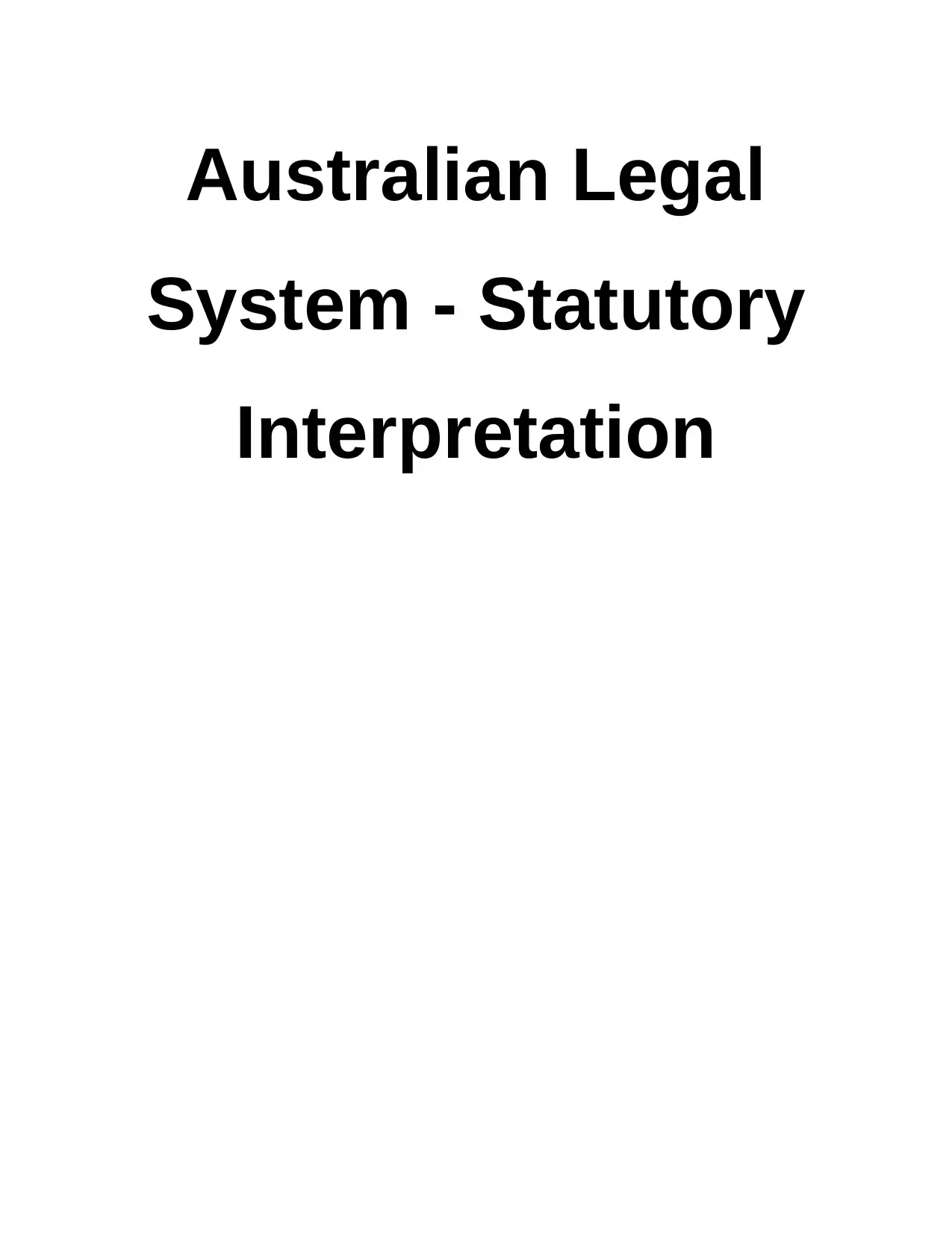
Australian Legal
System - Statutory
Interpretation
System - Statutory
Interpretation
Secure Best Marks with AI Grader
Need help grading? Try our AI Grader for instant feedback on your assignments.
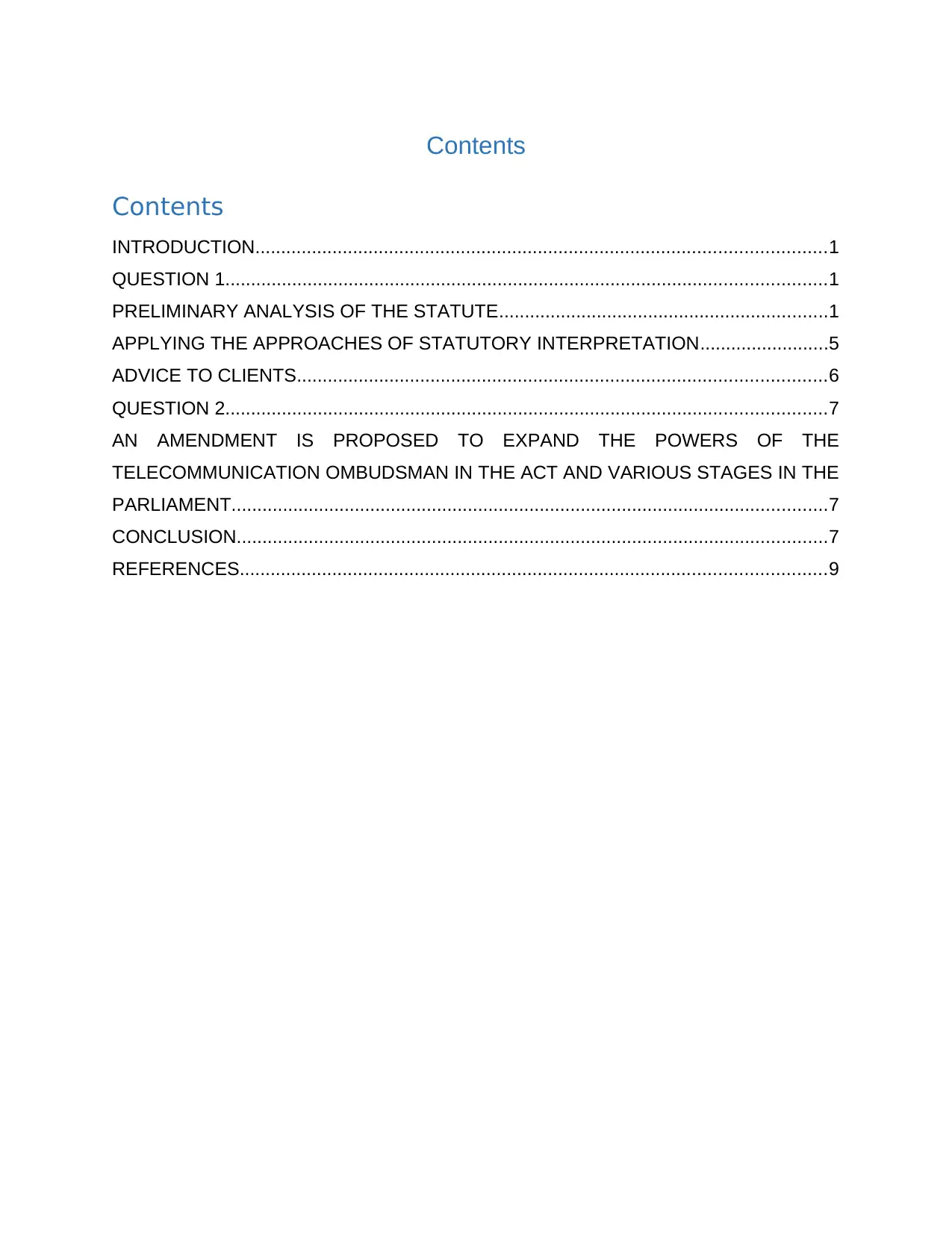
Contents
Contents
INTRODUCTION...............................................................................................................1
QUESTION 1.....................................................................................................................1
PRELIMINARY ANALYSIS OF THE STATUTE................................................................1
APPLYING THE APPROACHES OF STATUTORY INTERPRETATION.........................5
ADVICE TO CLIENTS.......................................................................................................6
QUESTION 2.....................................................................................................................7
AN AMENDMENT IS PROPOSED TO EXPAND THE POWERS OF THE
TELECOMMUNICATION OMBUDSMAN IN THE ACT AND VARIOUS STAGES IN THE
PARLIAMENT....................................................................................................................7
CONCLUSION...................................................................................................................7
REFERENCES..................................................................................................................9
Contents
INTRODUCTION...............................................................................................................1
QUESTION 1.....................................................................................................................1
PRELIMINARY ANALYSIS OF THE STATUTE................................................................1
APPLYING THE APPROACHES OF STATUTORY INTERPRETATION.........................5
ADVICE TO CLIENTS.......................................................................................................6
QUESTION 2.....................................................................................................................7
AN AMENDMENT IS PROPOSED TO EXPAND THE POWERS OF THE
TELECOMMUNICATION OMBUDSMAN IN THE ACT AND VARIOUS STAGES IN THE
PARLIAMENT....................................................................................................................7
CONCLUSION...................................................................................................................7
REFERENCES..................................................................................................................9
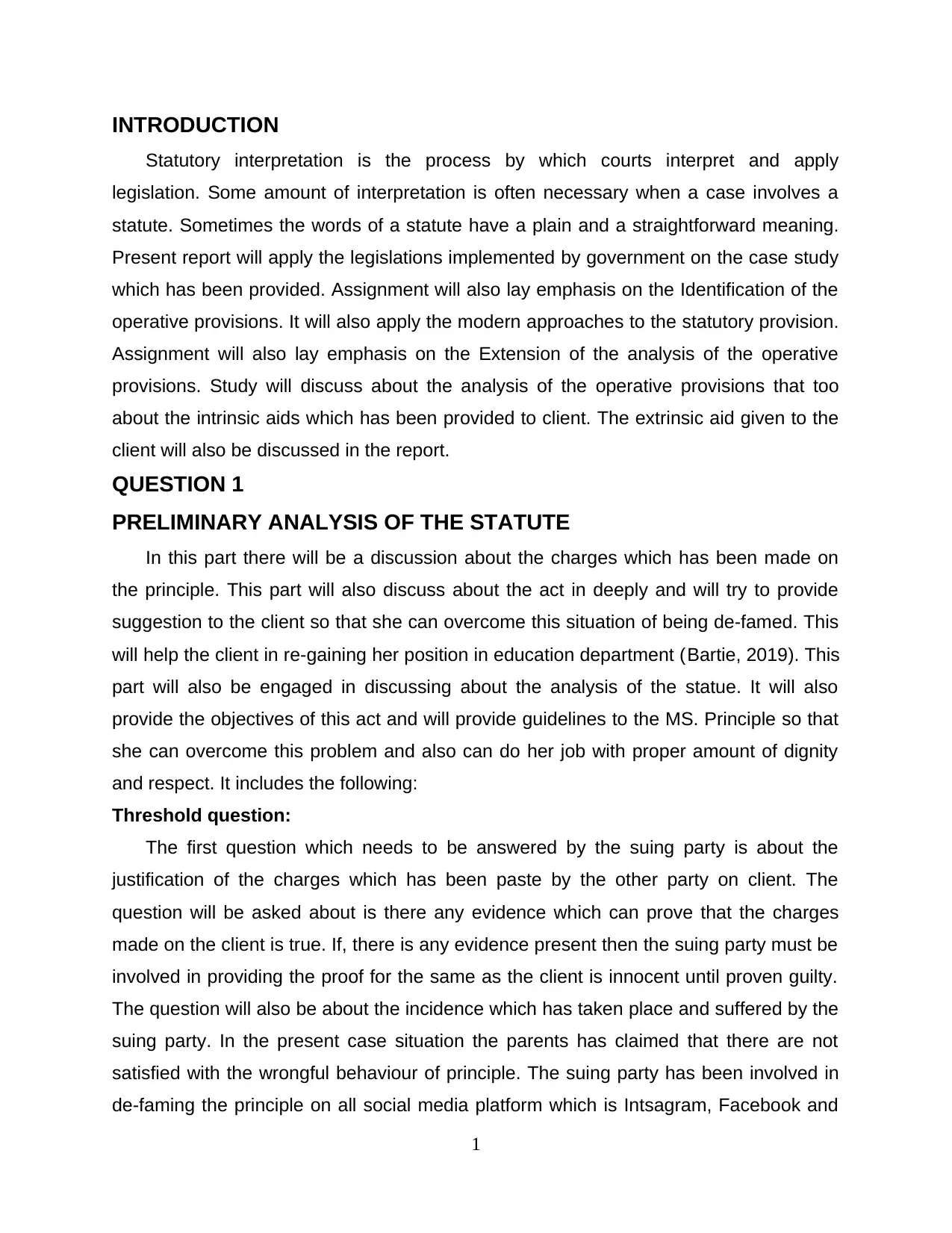
INTRODUCTION
Statutory interpretation is the process by which courts interpret and apply
legislation. Some amount of interpretation is often necessary when a case involves a
statute. Sometimes the words of a statute have a plain and a straightforward meaning.
Present report will apply the legislations implemented by government on the case study
which has been provided. Assignment will also lay emphasis on the Identification of the
operative provisions. It will also apply the modern approaches to the statutory provision.
Assignment will also lay emphasis on the Extension of the analysis of the operative
provisions. Study will discuss about the analysis of the operative provisions that too
about the intrinsic aids which has been provided to client. The extrinsic aid given to the
client will also be discussed in the report.
QUESTION 1
PRELIMINARY ANALYSIS OF THE STATUTE
In this part there will be a discussion about the charges which has been made on
the principle. This part will also discuss about the act in deeply and will try to provide
suggestion to the client so that she can overcome this situation of being de-famed. This
will help the client in re-gaining her position in education department (Bartie, 2019). This
part will also be engaged in discussing about the analysis of the statue. It will also
provide the objectives of this act and will provide guidelines to the MS. Principle so that
she can overcome this problem and also can do her job with proper amount of dignity
and respect. It includes the following:
Threshold question:
The first question which needs to be answered by the suing party is about the
justification of the charges which has been paste by the other party on client. The
question will be asked about is there any evidence which can prove that the charges
made on the client is true. If, there is any evidence present then the suing party must be
involved in providing the proof for the same as the client is innocent until proven guilty.
The question will also be about the incidence which has taken place and suffered by the
suing party. In the present case situation the parents has claimed that there are not
satisfied with the wrongful behaviour of principle. The suing party has been involved in
de-faming the principle on all social media platform which is Intsagram, Facebook and
1
Statutory interpretation is the process by which courts interpret and apply
legislation. Some amount of interpretation is often necessary when a case involves a
statute. Sometimes the words of a statute have a plain and a straightforward meaning.
Present report will apply the legislations implemented by government on the case study
which has been provided. Assignment will also lay emphasis on the Identification of the
operative provisions. It will also apply the modern approaches to the statutory provision.
Assignment will also lay emphasis on the Extension of the analysis of the operative
provisions. Study will discuss about the analysis of the operative provisions that too
about the intrinsic aids which has been provided to client. The extrinsic aid given to the
client will also be discussed in the report.
QUESTION 1
PRELIMINARY ANALYSIS OF THE STATUTE
In this part there will be a discussion about the charges which has been made on
the principle. This part will also discuss about the act in deeply and will try to provide
suggestion to the client so that she can overcome this situation of being de-famed. This
will help the client in re-gaining her position in education department (Bartie, 2019). This
part will also be engaged in discussing about the analysis of the statue. It will also
provide the objectives of this act and will provide guidelines to the MS. Principle so that
she can overcome this problem and also can do her job with proper amount of dignity
and respect. It includes the following:
Threshold question:
The first question which needs to be answered by the suing party is about the
justification of the charges which has been paste by the other party on client. The
question will be asked about is there any evidence which can prove that the charges
made on the client is true. If, there is any evidence present then the suing party must be
involved in providing the proof for the same as the client is innocent until proven guilty.
The question will also be about the incidence which has taken place and suffered by the
suing party. In the present case situation the parents has claimed that there are not
satisfied with the wrongful behaviour of principle. The suing party has been involved in
de-faming the principle on all social media platform which is Intsagram, Facebook and
1
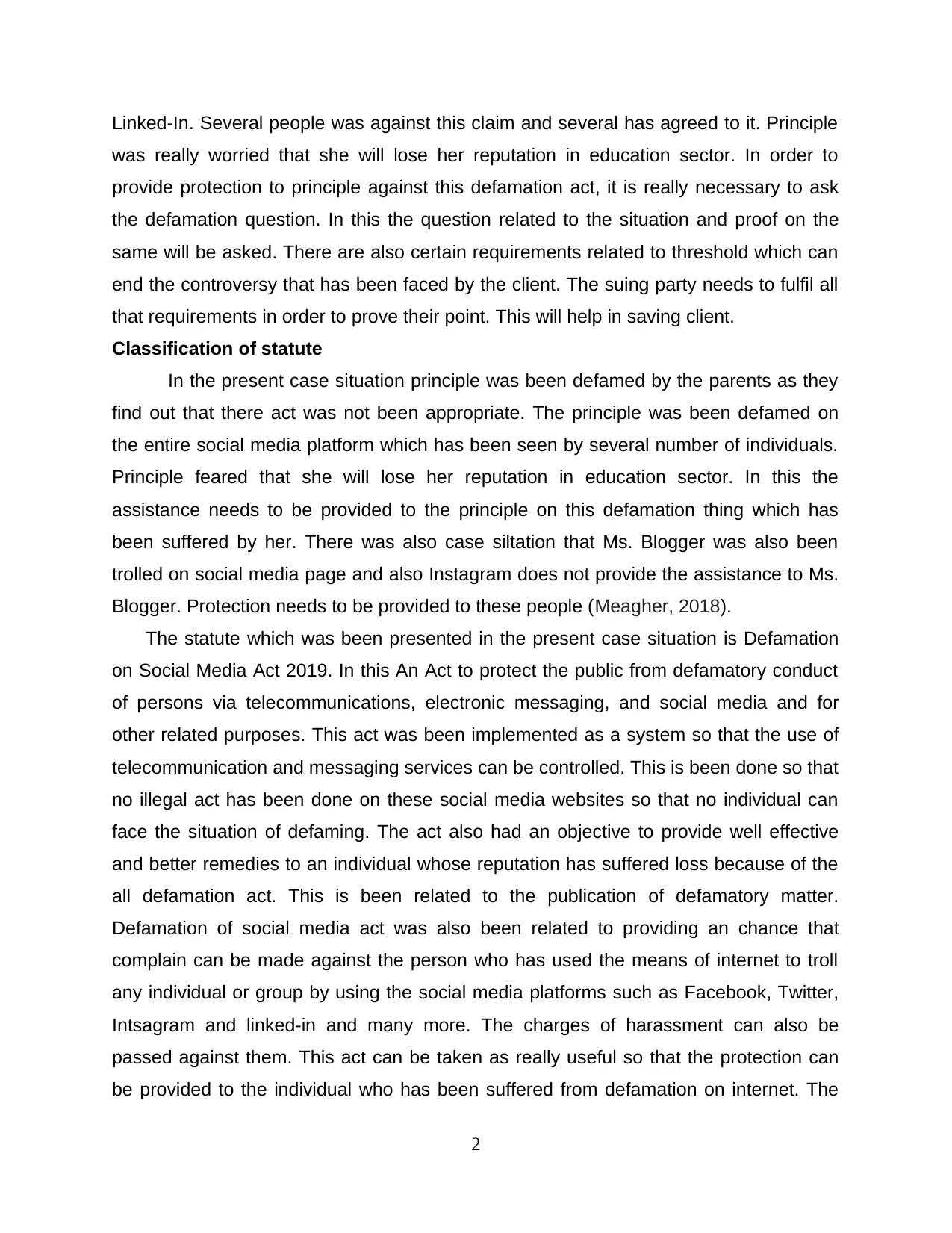
Linked-In. Several people was against this claim and several has agreed to it. Principle
was really worried that she will lose her reputation in education sector. In order to
provide protection to principle against this defamation act, it is really necessary to ask
the defamation question. In this the question related to the situation and proof on the
same will be asked. There are also certain requirements related to threshold which can
end the controversy that has been faced by the client. The suing party needs to fulfil all
that requirements in order to prove their point. This will help in saving client.
Classification of statute
In the present case situation principle was been defamed by the parents as they
find out that there act was not been appropriate. The principle was been defamed on
the entire social media platform which has been seen by several number of individuals.
Principle feared that she will lose her reputation in education sector. In this the
assistance needs to be provided to the principle on this defamation thing which has
been suffered by her. There was also case siltation that Ms. Blogger was also been
trolled on social media page and also Instagram does not provide the assistance to Ms.
Blogger. Protection needs to be provided to these people (Meagher, 2018).
The statute which was been presented in the present case situation is Defamation
on Social Media Act 2019. In this An Act to protect the public from defamatory conduct
of persons via telecommunications, electronic messaging, and social media and for
other related purposes. This act was been implemented as a system so that the use of
telecommunication and messaging services can be controlled. This is been done so that
no illegal act has been done on these social media websites so that no individual can
face the situation of defaming. The act also had an objective to provide well effective
and better remedies to an individual whose reputation has suffered loss because of the
all defamation act. This is been related to the publication of defamatory matter.
Defamation of social media act was also been related to providing an chance that
complain can be made against the person who has used the means of internet to troll
any individual or group by using the social media platforms such as Facebook, Twitter,
Intsagram and linked-in and many more. The charges of harassment can also be
passed against them. This act can be taken as really useful so that the protection can
be provided to the individual who has been suffered from defamation on internet. The
2
was really worried that she will lose her reputation in education sector. In order to
provide protection to principle against this defamation act, it is really necessary to ask
the defamation question. In this the question related to the situation and proof on the
same will be asked. There are also certain requirements related to threshold which can
end the controversy that has been faced by the client. The suing party needs to fulfil all
that requirements in order to prove their point. This will help in saving client.
Classification of statute
In the present case situation principle was been defamed by the parents as they
find out that there act was not been appropriate. The principle was been defamed on
the entire social media platform which has been seen by several number of individuals.
Principle feared that she will lose her reputation in education sector. In this the
assistance needs to be provided to the principle on this defamation thing which has
been suffered by her. There was also case siltation that Ms. Blogger was also been
trolled on social media page and also Instagram does not provide the assistance to Ms.
Blogger. Protection needs to be provided to these people (Meagher, 2018).
The statute which was been presented in the present case situation is Defamation
on Social Media Act 2019. In this An Act to protect the public from defamatory conduct
of persons via telecommunications, electronic messaging, and social media and for
other related purposes. This act was been implemented as a system so that the use of
telecommunication and messaging services can be controlled. This is been done so that
no illegal act has been done on these social media websites so that no individual can
face the situation of defaming. The act also had an objective to provide well effective
and better remedies to an individual whose reputation has suffered loss because of the
all defamation act. This is been related to the publication of defamatory matter.
Defamation of social media act was also been related to providing an chance that
complain can be made against the person who has used the means of internet to troll
any individual or group by using the social media platforms such as Facebook, Twitter,
Intsagram and linked-in and many more. The charges of harassment can also be
passed against them. This act can be taken as really useful so that the protection can
be provided to the individual who has been suffered from defamation on internet. The
2
Secure Best Marks with AI Grader
Need help grading? Try our AI Grader for instant feedback on your assignments.
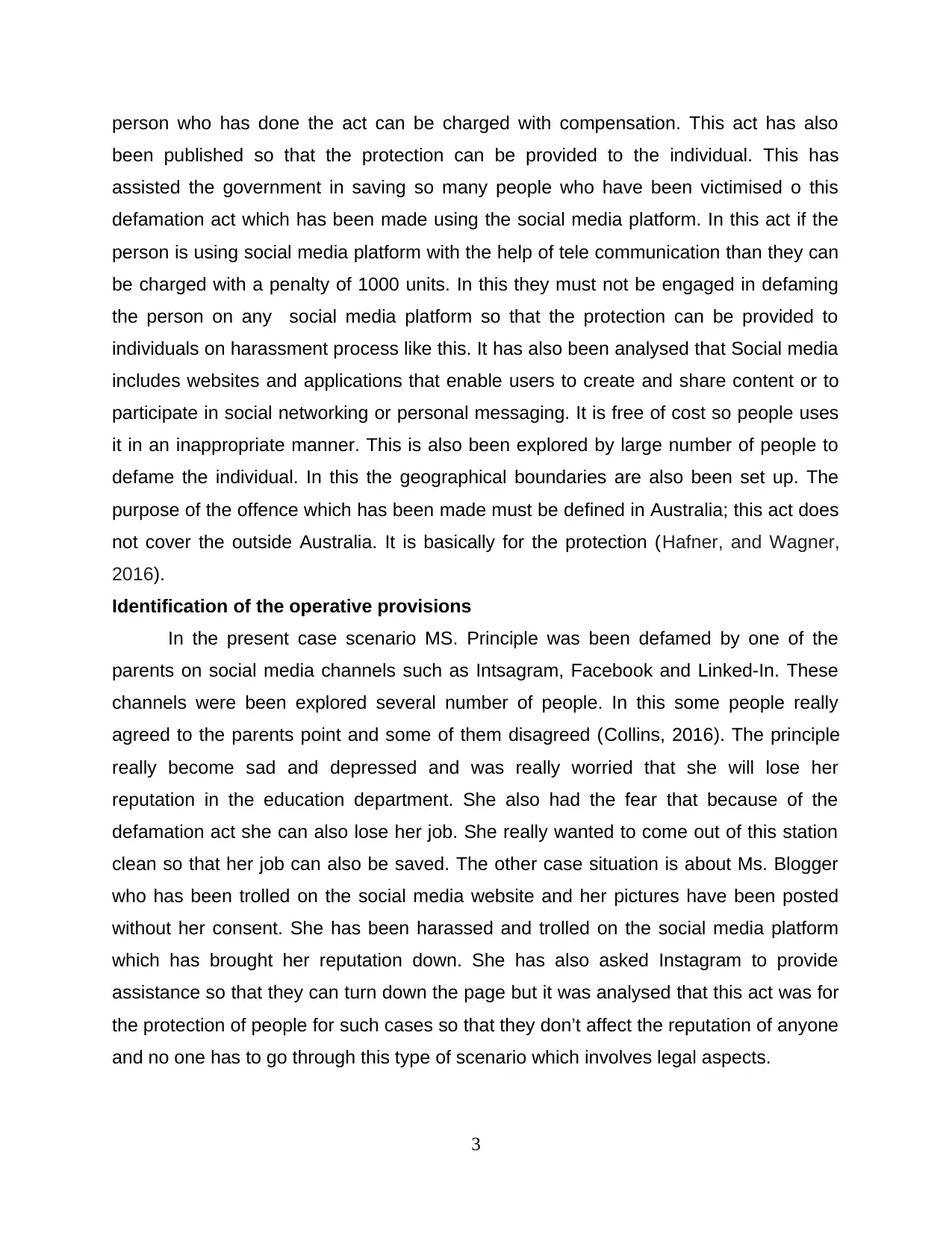
person who has done the act can be charged with compensation. This act has also
been published so that the protection can be provided to the individual. This has
assisted the government in saving so many people who have been victimised o this
defamation act which has been made using the social media platform. In this act if the
person is using social media platform with the help of tele communication than they can
be charged with a penalty of 1000 units. In this they must not be engaged in defaming
the person on any social media platform so that the protection can be provided to
individuals on harassment process like this. It has also been analysed that Social media
includes websites and applications that enable users to create and share content or to
participate in social networking or personal messaging. It is free of cost so people uses
it in an inappropriate manner. This is also been explored by large number of people to
defame the individual. In this the geographical boundaries are also been set up. The
purpose of the offence which has been made must be defined in Australia; this act does
not cover the outside Australia. It is basically for the protection (Hafner, and Wagner,
2016).
Identification of the operative provisions
In the present case scenario MS. Principle was been defamed by one of the
parents on social media channels such as Intsagram, Facebook and Linked-In. These
channels were been explored several number of people. In this some people really
agreed to the parents point and some of them disagreed (Collins, 2016). The principle
really become sad and depressed and was really worried that she will lose her
reputation in the education department. She also had the fear that because of the
defamation act she can also lose her job. She really wanted to come out of this station
clean so that her job can also be saved. The other case situation is about Ms. Blogger
who has been trolled on the social media website and her pictures have been posted
without her consent. She has been harassed and trolled on the social media platform
which has brought her reputation down. She has also asked Instagram to provide
assistance so that they can turn down the page but it was analysed that this act was for
the protection of people for such cases so that they don’t affect the reputation of anyone
and no one has to go through this type of scenario which involves legal aspects.
3
been published so that the protection can be provided to the individual. This has
assisted the government in saving so many people who have been victimised o this
defamation act which has been made using the social media platform. In this act if the
person is using social media platform with the help of tele communication than they can
be charged with a penalty of 1000 units. In this they must not be engaged in defaming
the person on any social media platform so that the protection can be provided to
individuals on harassment process like this. It has also been analysed that Social media
includes websites and applications that enable users to create and share content or to
participate in social networking or personal messaging. It is free of cost so people uses
it in an inappropriate manner. This is also been explored by large number of people to
defame the individual. In this the geographical boundaries are also been set up. The
purpose of the offence which has been made must be defined in Australia; this act does
not cover the outside Australia. It is basically for the protection (Hafner, and Wagner,
2016).
Identification of the operative provisions
In the present case scenario MS. Principle was been defamed by one of the
parents on social media channels such as Intsagram, Facebook and Linked-In. These
channels were been explored several number of people. In this some people really
agreed to the parents point and some of them disagreed (Collins, 2016). The principle
really become sad and depressed and was really worried that she will lose her
reputation in the education department. She also had the fear that because of the
defamation act she can also lose her job. She really wanted to come out of this station
clean so that her job can also be saved. The other case situation is about Ms. Blogger
who has been trolled on the social media website and her pictures have been posted
without her consent. She has been harassed and trolled on the social media platform
which has brought her reputation down. She has also asked Instagram to provide
assistance so that they can turn down the page but it was analysed that this act was for
the protection of people for such cases so that they don’t affect the reputation of anyone
and no one has to go through this type of scenario which involves legal aspects.
3
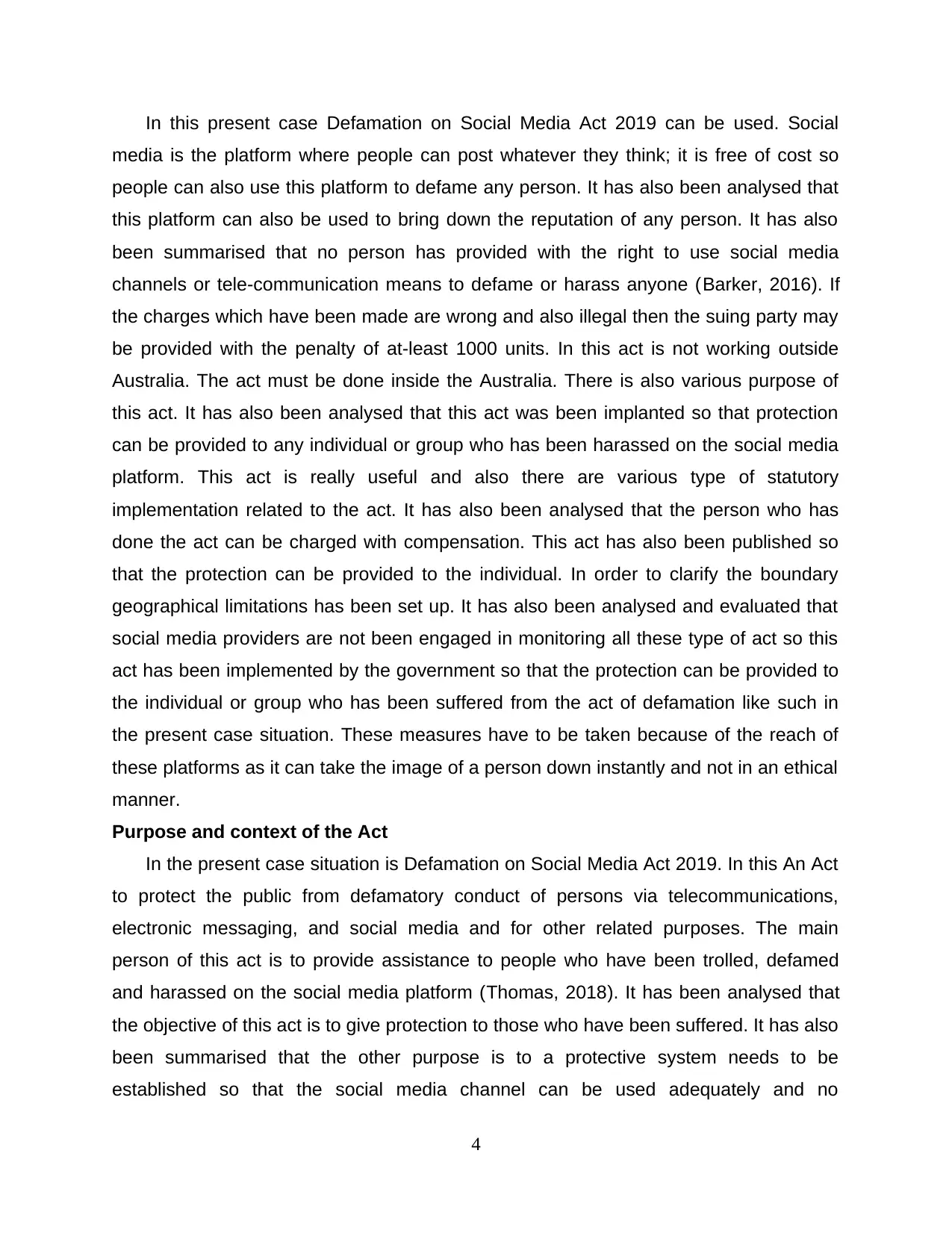
In this present case Defamation on Social Media Act 2019 can be used. Social
media is the platform where people can post whatever they think; it is free of cost so
people can also use this platform to defame any person. It has also been analysed that
this platform can also be used to bring down the reputation of any person. It has also
been summarised that no person has provided with the right to use social media
channels or tele-communication means to defame or harass anyone (Barker, 2016). If
the charges which have been made are wrong and also illegal then the suing party may
be provided with the penalty of at-least 1000 units. In this act is not working outside
Australia. The act must be done inside the Australia. There is also various purpose of
this act. It has also been analysed that this act was been implanted so that protection
can be provided to any individual or group who has been harassed on the social media
platform. This act is really useful and also there are various type of statutory
implementation related to the act. It has also been analysed that the person who has
done the act can be charged with compensation. This act has also been published so
that the protection can be provided to the individual. In order to clarify the boundary
geographical limitations has been set up. It has also been analysed and evaluated that
social media providers are not been engaged in monitoring all these type of act so this
act has been implemented by the government so that the protection can be provided to
the individual or group who has been suffered from the act of defamation like such in
the present case situation. These measures have to be taken because of the reach of
these platforms as it can take the image of a person down instantly and not in an ethical
manner.
Purpose and context of the Act
In the present case situation is Defamation on Social Media Act 2019. In this An Act
to protect the public from defamatory conduct of persons via telecommunications,
electronic messaging, and social media and for other related purposes. The main
person of this act is to provide assistance to people who have been trolled, defamed
and harassed on the social media platform (Thomas, 2018). It has been analysed that
the objective of this act is to give protection to those who have been suffered. It has also
been summarised that the other purpose is to a protective system needs to be
established so that the social media channel can be used adequately and no
4
media is the platform where people can post whatever they think; it is free of cost so
people can also use this platform to defame any person. It has also been analysed that
this platform can also be used to bring down the reputation of any person. It has also
been summarised that no person has provided with the right to use social media
channels or tele-communication means to defame or harass anyone (Barker, 2016). If
the charges which have been made are wrong and also illegal then the suing party may
be provided with the penalty of at-least 1000 units. In this act is not working outside
Australia. The act must be done inside the Australia. There is also various purpose of
this act. It has also been analysed that this act was been implanted so that protection
can be provided to any individual or group who has been harassed on the social media
platform. This act is really useful and also there are various type of statutory
implementation related to the act. It has also been analysed that the person who has
done the act can be charged with compensation. This act has also been published so
that the protection can be provided to the individual. In order to clarify the boundary
geographical limitations has been set up. It has also been analysed and evaluated that
social media providers are not been engaged in monitoring all these type of act so this
act has been implemented by the government so that the protection can be provided to
the individual or group who has been suffered from the act of defamation like such in
the present case situation. These measures have to be taken because of the reach of
these platforms as it can take the image of a person down instantly and not in an ethical
manner.
Purpose and context of the Act
In the present case situation is Defamation on Social Media Act 2019. In this An Act
to protect the public from defamatory conduct of persons via telecommunications,
electronic messaging, and social media and for other related purposes. The main
person of this act is to provide assistance to people who have been trolled, defamed
and harassed on the social media platform (Thomas, 2018). It has been analysed that
the objective of this act is to give protection to those who have been suffered. It has also
been summarised that the other purpose is to a protective system needs to be
established so that the social media channel can be used adequately and no
4
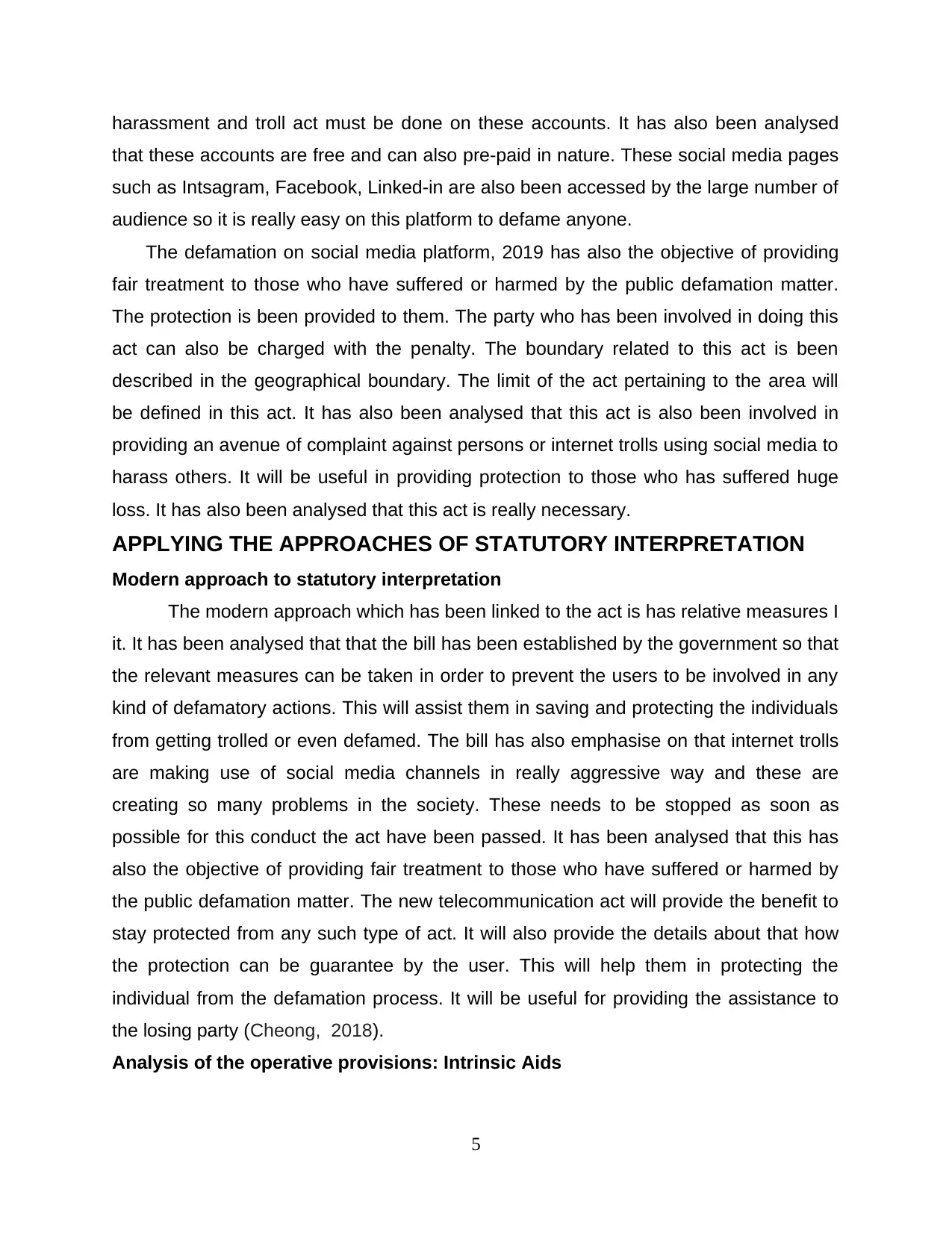
harassment and troll act must be done on these accounts. It has also been analysed
that these accounts are free and can also pre-paid in nature. These social media pages
such as Intsagram, Facebook, Linked-in are also been accessed by the large number of
audience so it is really easy on this platform to defame anyone.
The defamation on social media platform, 2019 has also the objective of providing
fair treatment to those who have suffered or harmed by the public defamation matter.
The protection is been provided to them. The party who has been involved in doing this
act can also be charged with the penalty. The boundary related to this act is been
described in the geographical boundary. The limit of the act pertaining to the area will
be defined in this act. It has also been analysed that this act is also been involved in
providing an avenue of complaint against persons or internet trolls using social media to
harass others. It will be useful in providing protection to those who has suffered huge
loss. It has also been analysed that this act is really necessary.
APPLYING THE APPROACHES OF STATUTORY INTERPRETATION
Modern approach to statutory interpretation
The modern approach which has been linked to the act is has relative measures I
it. It has been analysed that that the bill has been established by the government so that
the relevant measures can be taken in order to prevent the users to be involved in any
kind of defamatory actions. This will assist them in saving and protecting the individuals
from getting trolled or even defamed. The bill has also emphasise on that internet trolls
are making use of social media channels in really aggressive way and these are
creating so many problems in the society. These needs to be stopped as soon as
possible for this conduct the act have been passed. It has been analysed that this has
also the objective of providing fair treatment to those who have suffered or harmed by
the public defamation matter. The new telecommunication act will provide the benefit to
stay protected from any such type of act. It will also provide the details about that how
the protection can be guarantee by the user. This will help them in protecting the
individual from the defamation process. It will be useful for providing the assistance to
the losing party (Cheong, 2018).
Analysis of the operative provisions: Intrinsic Aids
5
that these accounts are free and can also pre-paid in nature. These social media pages
such as Intsagram, Facebook, Linked-in are also been accessed by the large number of
audience so it is really easy on this platform to defame anyone.
The defamation on social media platform, 2019 has also the objective of providing
fair treatment to those who have suffered or harmed by the public defamation matter.
The protection is been provided to them. The party who has been involved in doing this
act can also be charged with the penalty. The boundary related to this act is been
described in the geographical boundary. The limit of the act pertaining to the area will
be defined in this act. It has also been analysed that this act is also been involved in
providing an avenue of complaint against persons or internet trolls using social media to
harass others. It will be useful in providing protection to those who has suffered huge
loss. It has also been analysed that this act is really necessary.
APPLYING THE APPROACHES OF STATUTORY INTERPRETATION
Modern approach to statutory interpretation
The modern approach which has been linked to the act is has relative measures I
it. It has been analysed that that the bill has been established by the government so that
the relevant measures can be taken in order to prevent the users to be involved in any
kind of defamatory actions. This will assist them in saving and protecting the individuals
from getting trolled or even defamed. The bill has also emphasise on that internet trolls
are making use of social media channels in really aggressive way and these are
creating so many problems in the society. These needs to be stopped as soon as
possible for this conduct the act have been passed. It has been analysed that this has
also the objective of providing fair treatment to those who have suffered or harmed by
the public defamation matter. The new telecommunication act will provide the benefit to
stay protected from any such type of act. It will also provide the details about that how
the protection can be guarantee by the user. This will help them in protecting the
individual from the defamation process. It will be useful for providing the assistance to
the losing party (Cheong, 2018).
Analysis of the operative provisions: Intrinsic Aids
5
Paraphrase This Document
Need a fresh take? Get an instant paraphrase of this document with our AI Paraphraser
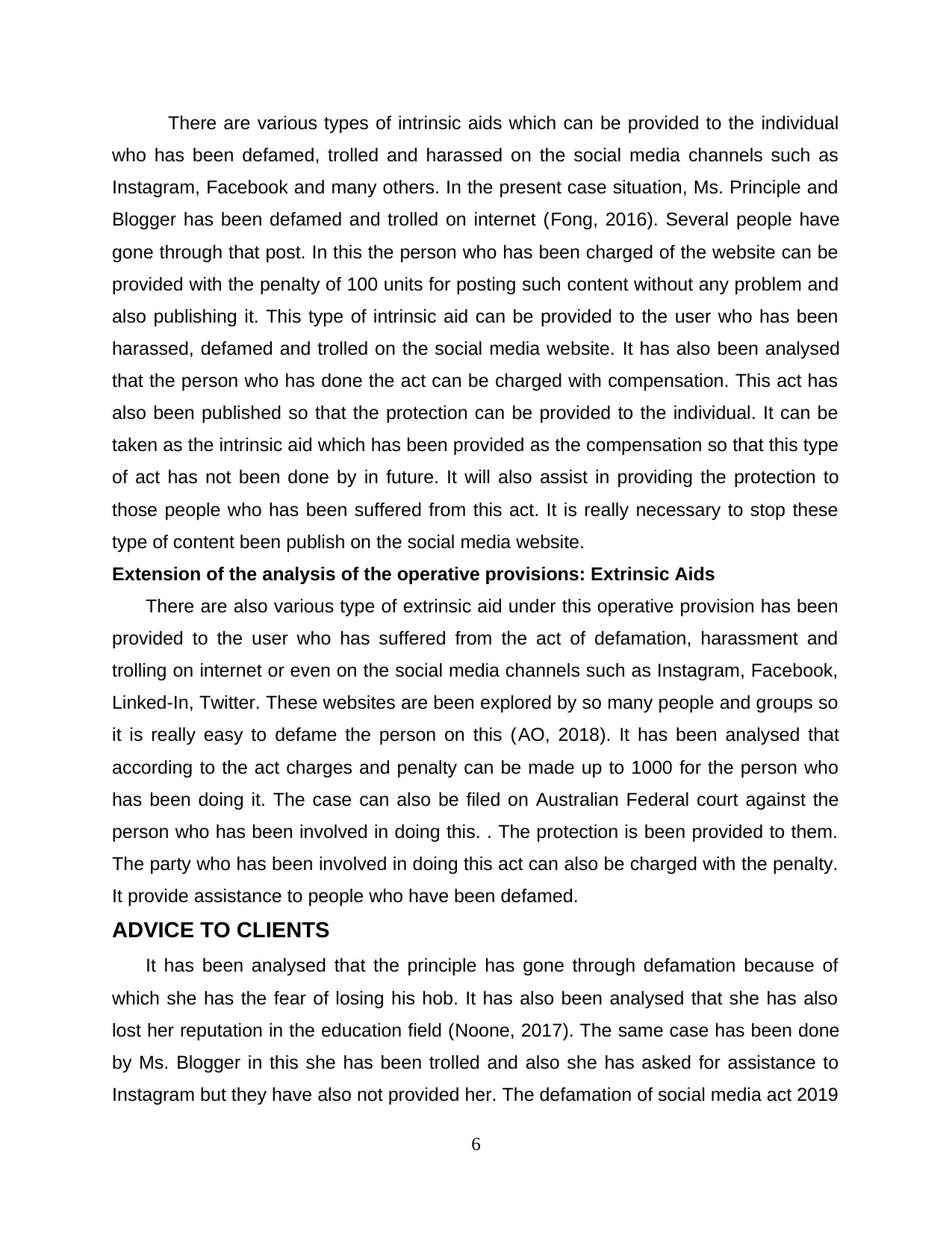
There are various types of intrinsic aids which can be provided to the individual
who has been defamed, trolled and harassed on the social media channels such as
Instagram, Facebook and many others. In the present case situation, Ms. Principle and
Blogger has been defamed and trolled on internet (Fong, 2016). Several people have
gone through that post. In this the person who has been charged of the website can be
provided with the penalty of 100 units for posting such content without any problem and
also publishing it. This type of intrinsic aid can be provided to the user who has been
harassed, defamed and trolled on the social media website. It has also been analysed
that the person who has done the act can be charged with compensation. This act has
also been published so that the protection can be provided to the individual. It can be
taken as the intrinsic aid which has been provided as the compensation so that this type
of act has not been done by in future. It will also assist in providing the protection to
those people who has been suffered from this act. It is really necessary to stop these
type of content been publish on the social media website.
Extension of the analysis of the operative provisions: Extrinsic Aids
There are also various type of extrinsic aid under this operative provision has been
provided to the user who has suffered from the act of defamation, harassment and
trolling on internet or even on the social media channels such as Instagram, Facebook,
Linked-In, Twitter. These websites are been explored by so many people and groups so
it is really easy to defame the person on this (AO, 2018). It has been analysed that
according to the act charges and penalty can be made up to 1000 for the person who
has been doing it. The case can also be filed on Australian Federal court against the
person who has been involved in doing this. . The protection is been provided to them.
The party who has been involved in doing this act can also be charged with the penalty.
It provide assistance to people who have been defamed.
ADVICE TO CLIENTS
It has been analysed that the principle has gone through defamation because of
which she has the fear of losing his hob. It has also been analysed that she has also
lost her reputation in the education field (Noone, 2017). The same case has been done
by Ms. Blogger in this she has been trolled and also she has asked for assistance to
Instagram but they have also not provided her. The defamation of social media act 2019
6
who has been defamed, trolled and harassed on the social media channels such as
Instagram, Facebook and many others. In the present case situation, Ms. Principle and
Blogger has been defamed and trolled on internet (Fong, 2016). Several people have
gone through that post. In this the person who has been charged of the website can be
provided with the penalty of 100 units for posting such content without any problem and
also publishing it. This type of intrinsic aid can be provided to the user who has been
harassed, defamed and trolled on the social media website. It has also been analysed
that the person who has done the act can be charged with compensation. This act has
also been published so that the protection can be provided to the individual. It can be
taken as the intrinsic aid which has been provided as the compensation so that this type
of act has not been done by in future. It will also assist in providing the protection to
those people who has been suffered from this act. It is really necessary to stop these
type of content been publish on the social media website.
Extension of the analysis of the operative provisions: Extrinsic Aids
There are also various type of extrinsic aid under this operative provision has been
provided to the user who has suffered from the act of defamation, harassment and
trolling on internet or even on the social media channels such as Instagram, Facebook,
Linked-In, Twitter. These websites are been explored by so many people and groups so
it is really easy to defame the person on this (AO, 2018). It has been analysed that
according to the act charges and penalty can be made up to 1000 for the person who
has been doing it. The case can also be filed on Australian Federal court against the
person who has been involved in doing this. . The protection is been provided to them.
The party who has been involved in doing this act can also be charged with the penalty.
It provide assistance to people who have been defamed.
ADVICE TO CLIENTS
It has been analysed that the principle has gone through defamation because of
which she has the fear of losing his hob. It has also been analysed that she has also
lost her reputation in the education field (Noone, 2017). The same case has been done
by Ms. Blogger in this she has been trolled and also she has asked for assistance to
Instagram but they have also not provided her. The defamation of social media act 2019
6
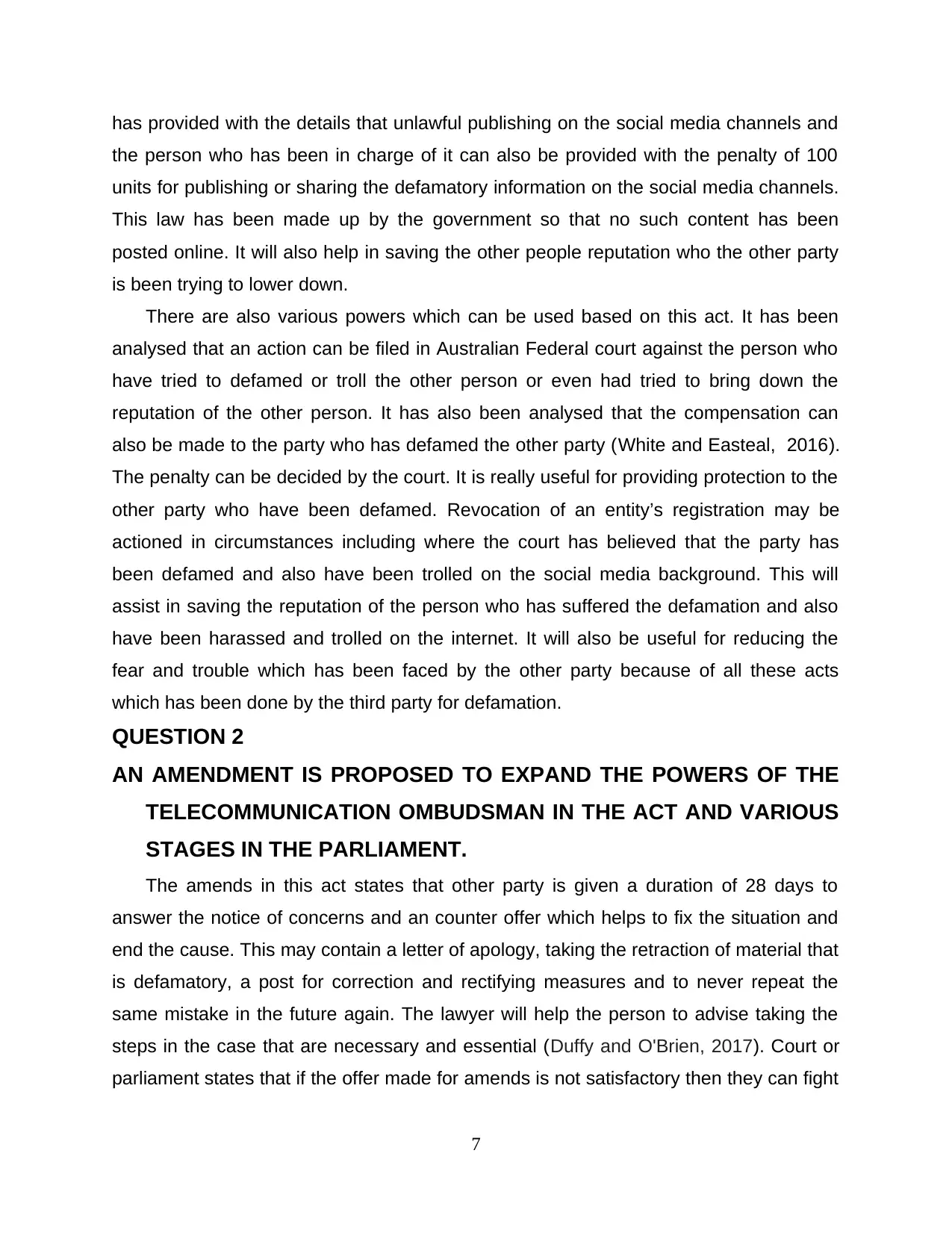
has provided with the details that unlawful publishing on the social media channels and
the person who has been in charge of it can also be provided with the penalty of 100
units for publishing or sharing the defamatory information on the social media channels.
This law has been made up by the government so that no such content has been
posted online. It will also help in saving the other people reputation who the other party
is been trying to lower down.
There are also various powers which can be used based on this act. It has been
analysed that an action can be filed in Australian Federal court against the person who
have tried to defamed or troll the other person or even had tried to bring down the
reputation of the other person. It has also been analysed that the compensation can
also be made to the party who has defamed the other party (White and Easteal, 2016).
The penalty can be decided by the court. It is really useful for providing protection to the
other party who have been defamed. Revocation of an entity’s registration may be
actioned in circumstances including where the court has believed that the party has
been defamed and also have been trolled on the social media background. This will
assist in saving the reputation of the person who has suffered the defamation and also
have been harassed and trolled on the internet. It will also be useful for reducing the
fear and trouble which has been faced by the other party because of all these acts
which has been done by the third party for defamation.
QUESTION 2
AN AMENDMENT IS PROPOSED TO EXPAND THE POWERS OF THE
TELECOMMUNICATION OMBUDSMAN IN THE ACT AND VARIOUS
STAGES IN THE PARLIAMENT.
The amends in this act states that other party is given a duration of 28 days to
answer the notice of concerns and an counter offer which helps to fix the situation and
end the cause. This may contain a letter of apology, taking the retraction of material that
is defamatory, a post for correction and rectifying measures and to never repeat the
same mistake in the future again. The lawyer will help the person to advise taking the
steps in the case that are necessary and essential (Duffy and O'Brien, 2017). Court or
parliament states that if the offer made for amends is not satisfactory then they can fight
7
the person who has been in charge of it can also be provided with the penalty of 100
units for publishing or sharing the defamatory information on the social media channels.
This law has been made up by the government so that no such content has been
posted online. It will also help in saving the other people reputation who the other party
is been trying to lower down.
There are also various powers which can be used based on this act. It has been
analysed that an action can be filed in Australian Federal court against the person who
have tried to defamed or troll the other person or even had tried to bring down the
reputation of the other person. It has also been analysed that the compensation can
also be made to the party who has defamed the other party (White and Easteal, 2016).
The penalty can be decided by the court. It is really useful for providing protection to the
other party who have been defamed. Revocation of an entity’s registration may be
actioned in circumstances including where the court has believed that the party has
been defamed and also have been trolled on the social media background. This will
assist in saving the reputation of the person who has suffered the defamation and also
have been harassed and trolled on the internet. It will also be useful for reducing the
fear and trouble which has been faced by the other party because of all these acts
which has been done by the third party for defamation.
QUESTION 2
AN AMENDMENT IS PROPOSED TO EXPAND THE POWERS OF THE
TELECOMMUNICATION OMBUDSMAN IN THE ACT AND VARIOUS
STAGES IN THE PARLIAMENT.
The amends in this act states that other party is given a duration of 28 days to
answer the notice of concerns and an counter offer which helps to fix the situation and
end the cause. This may contain a letter of apology, taking the retraction of material that
is defamatory, a post for correction and rectifying measures and to never repeat the
same mistake in the future again. The lawyer will help the person to advise taking the
steps in the case that are necessary and essential (Duffy and O'Brien, 2017). Court or
parliament states that if the offer made for amends is not satisfactory then they can fight
7
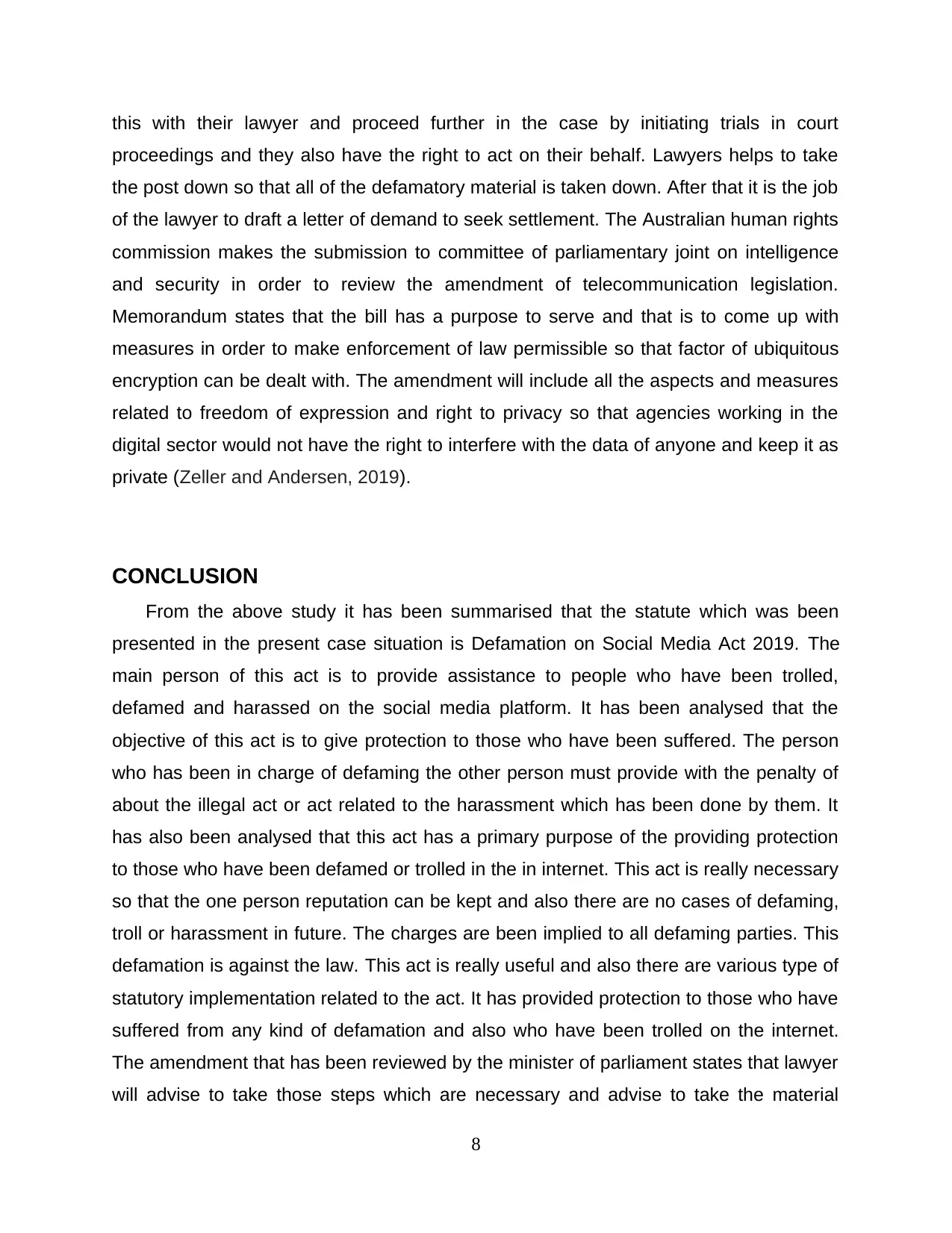
this with their lawyer and proceed further in the case by initiating trials in court
proceedings and they also have the right to act on their behalf. Lawyers helps to take
the post down so that all of the defamatory material is taken down. After that it is the job
of the lawyer to draft a letter of demand to seek settlement. The Australian human rights
commission makes the submission to committee of parliamentary joint on intelligence
and security in order to review the amendment of telecommunication legislation.
Memorandum states that the bill has a purpose to serve and that is to come up with
measures in order to make enforcement of law permissible so that factor of ubiquitous
encryption can be dealt with. The amendment will include all the aspects and measures
related to freedom of expression and right to privacy so that agencies working in the
digital sector would not have the right to interfere with the data of anyone and keep it as
private (Zeller and Andersen, 2019).
CONCLUSION
From the above study it has been summarised that the statute which was been
presented in the present case situation is Defamation on Social Media Act 2019. The
main person of this act is to provide assistance to people who have been trolled,
defamed and harassed on the social media platform. It has been analysed that the
objective of this act is to give protection to those who have been suffered. The person
who has been in charge of defaming the other person must provide with the penalty of
about the illegal act or act related to the harassment which has been done by them. It
has also been analysed that this act has a primary purpose of the providing protection
to those who have been defamed or trolled in the in internet. This act is really necessary
so that the one person reputation can be kept and also there are no cases of defaming,
troll or harassment in future. The charges are been implied to all defaming parties. This
defamation is against the law. This act is really useful and also there are various type of
statutory implementation related to the act. It has provided protection to those who have
suffered from any kind of defamation and also who have been trolled on the internet.
The amendment that has been reviewed by the minister of parliament states that lawyer
will advise to take those steps which are necessary and advise to take the material
8
proceedings and they also have the right to act on their behalf. Lawyers helps to take
the post down so that all of the defamatory material is taken down. After that it is the job
of the lawyer to draft a letter of demand to seek settlement. The Australian human rights
commission makes the submission to committee of parliamentary joint on intelligence
and security in order to review the amendment of telecommunication legislation.
Memorandum states that the bill has a purpose to serve and that is to come up with
measures in order to make enforcement of law permissible so that factor of ubiquitous
encryption can be dealt with. The amendment will include all the aspects and measures
related to freedom of expression and right to privacy so that agencies working in the
digital sector would not have the right to interfere with the data of anyone and keep it as
private (Zeller and Andersen, 2019).
CONCLUSION
From the above study it has been summarised that the statute which was been
presented in the present case situation is Defamation on Social Media Act 2019. The
main person of this act is to provide assistance to people who have been trolled,
defamed and harassed on the social media platform. It has been analysed that the
objective of this act is to give protection to those who have been suffered. The person
who has been in charge of defaming the other person must provide with the penalty of
about the illegal act or act related to the harassment which has been done by them. It
has also been analysed that this act has a primary purpose of the providing protection
to those who have been defamed or trolled in the in internet. This act is really necessary
so that the one person reputation can be kept and also there are no cases of defaming,
troll or harassment in future. The charges are been implied to all defaming parties. This
defamation is against the law. This act is really useful and also there are various type of
statutory implementation related to the act. It has provided protection to those who have
suffered from any kind of defamation and also who have been trolled on the internet.
The amendment that has been reviewed by the minister of parliament states that lawyer
will advise to take those steps which are necessary and advise to take the material
8
Secure Best Marks with AI Grader
Need help grading? Try our AI Grader for instant feedback on your assignments.
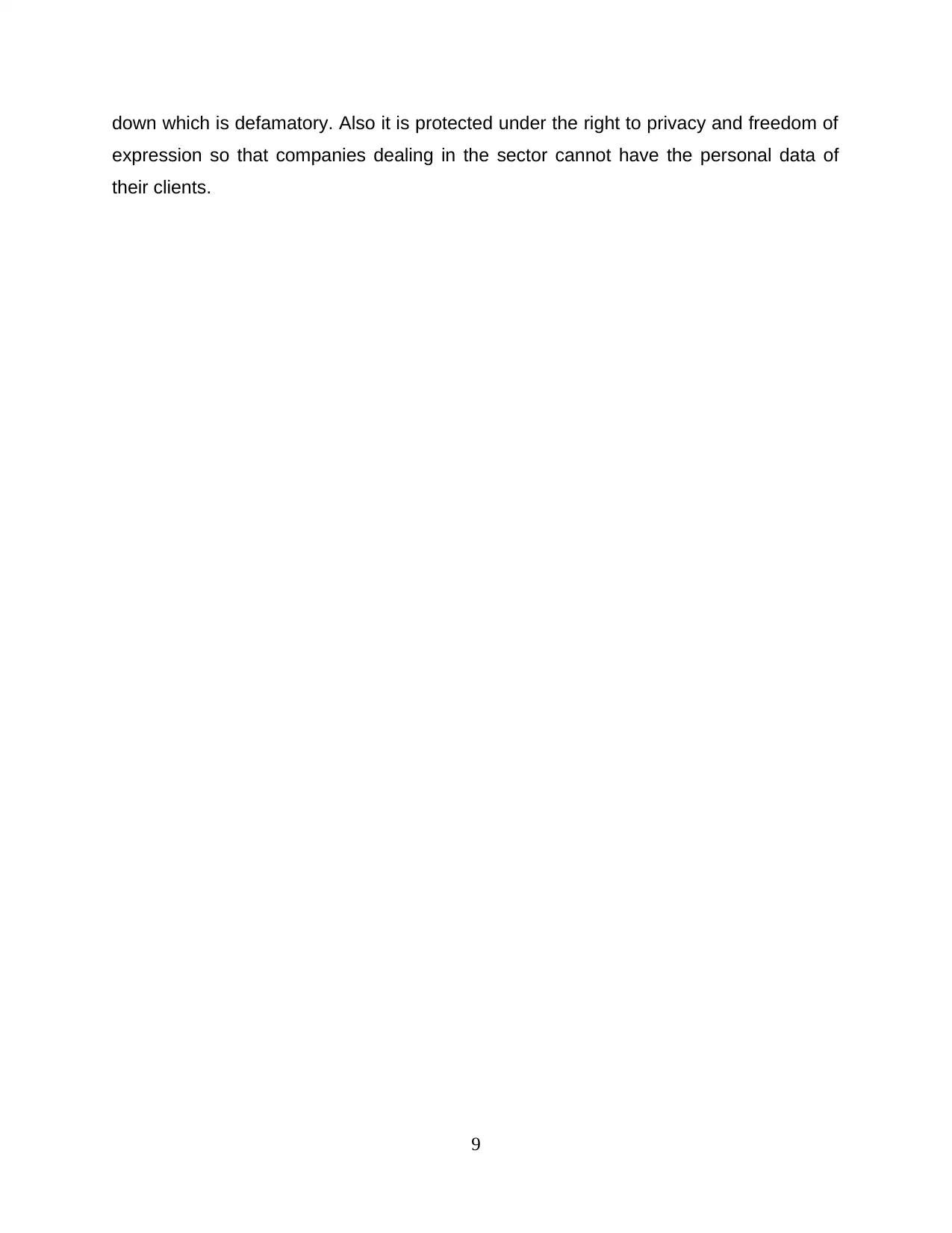
down which is defamatory. Also it is protected under the right to privacy and freedom of
expression so that companies dealing in the sector cannot have the personal data of
their clients.
9
expression so that companies dealing in the sector cannot have the personal data of
their clients.
9
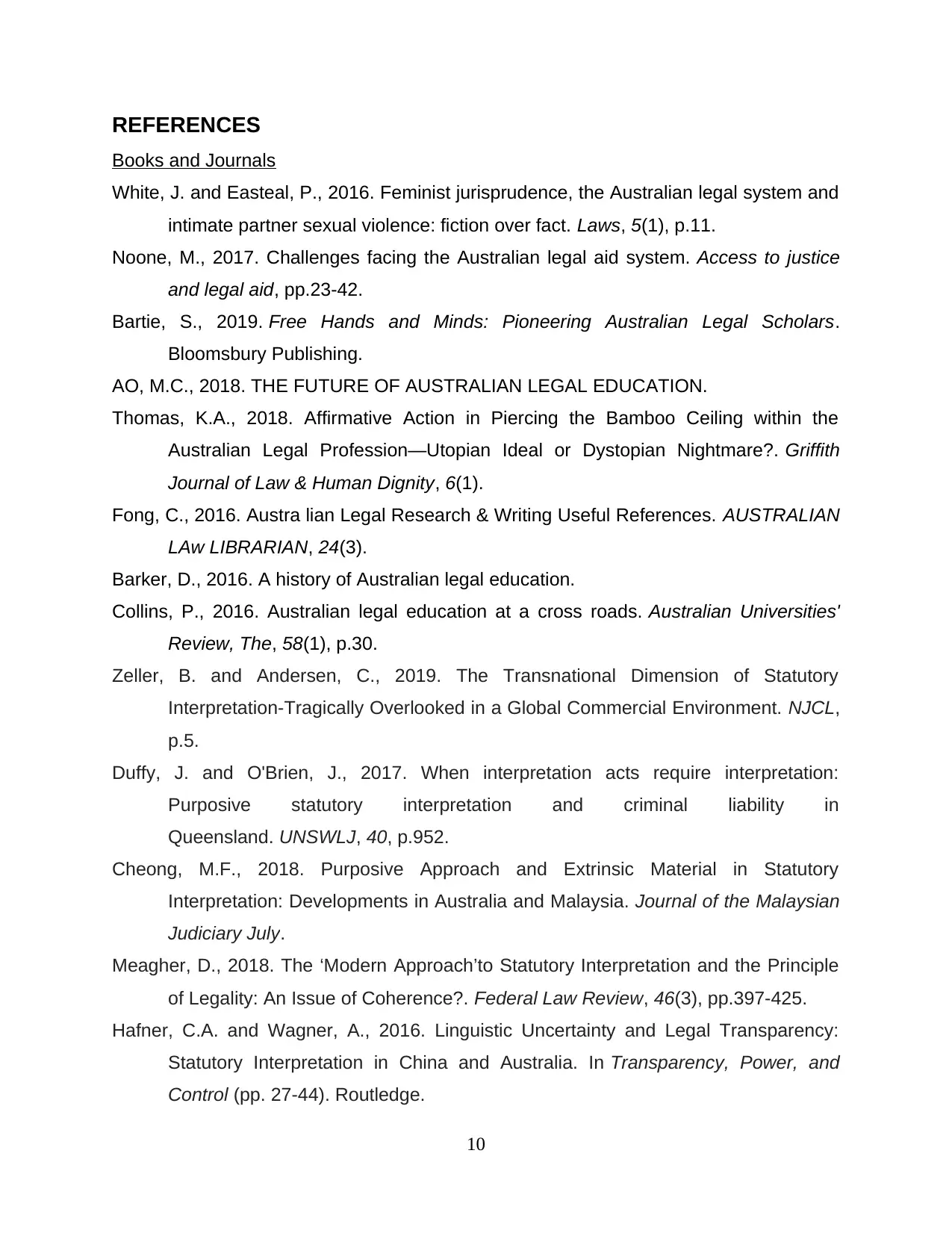
REFERENCES
Books and Journals
White, J. and Easteal, P., 2016. Feminist jurisprudence, the Australian legal system and
intimate partner sexual violence: fiction over fact. Laws, 5(1), p.11.
Noone, M., 2017. Challenges facing the Australian legal aid system. Access to justice
and legal aid, pp.23-42.
Bartie, S., 2019. Free Hands and Minds: Pioneering Australian Legal Scholars.
Bloomsbury Publishing.
AO, M.C., 2018. THE FUTURE OF AUSTRALIAN LEGAL EDUCATION.
Thomas, K.A., 2018. Affirmative Action in Piercing the Bamboo Ceiling within the
Australian Legal Profession—Utopian Ideal or Dystopian Nightmare?. Griffith
Journal of Law & Human Dignity, 6(1).
Fong, C., 2016. Austra lian Legal Research & Writing Useful References. AUSTRALIAN
LAw LIBRARIAN, 24(3).
Barker, D., 2016. A history of Australian legal education.
Collins, P., 2016. Australian legal education at a cross roads. Australian Universities'
Review, The, 58(1), p.30.
Zeller, B. and Andersen, C., 2019. The Transnational Dimension of Statutory
Interpretation-Tragically Overlooked in a Global Commercial Environment. NJCL,
p.5.
Duffy, J. and O'Brien, J., 2017. When interpretation acts require interpretation:
Purposive statutory interpretation and criminal liability in
Queensland. UNSWLJ, 40, p.952.
Cheong, M.F., 2018. Purposive Approach and Extrinsic Material in Statutory
Interpretation: Developments in Australia and Malaysia. Journal of the Malaysian
Judiciary July.
Meagher, D., 2018. The ‘Modern Approach’to Statutory Interpretation and the Principle
of Legality: An Issue of Coherence?. Federal Law Review, 46(3), pp.397-425.
Hafner, C.A. and Wagner, A., 2016. Linguistic Uncertainty and Legal Transparency:
Statutory Interpretation in China and Australia. In Transparency, Power, and
Control (pp. 27-44). Routledge.
10
Books and Journals
White, J. and Easteal, P., 2016. Feminist jurisprudence, the Australian legal system and
intimate partner sexual violence: fiction over fact. Laws, 5(1), p.11.
Noone, M., 2017. Challenges facing the Australian legal aid system. Access to justice
and legal aid, pp.23-42.
Bartie, S., 2019. Free Hands and Minds: Pioneering Australian Legal Scholars.
Bloomsbury Publishing.
AO, M.C., 2018. THE FUTURE OF AUSTRALIAN LEGAL EDUCATION.
Thomas, K.A., 2018. Affirmative Action in Piercing the Bamboo Ceiling within the
Australian Legal Profession—Utopian Ideal or Dystopian Nightmare?. Griffith
Journal of Law & Human Dignity, 6(1).
Fong, C., 2016. Austra lian Legal Research & Writing Useful References. AUSTRALIAN
LAw LIBRARIAN, 24(3).
Barker, D., 2016. A history of Australian legal education.
Collins, P., 2016. Australian legal education at a cross roads. Australian Universities'
Review, The, 58(1), p.30.
Zeller, B. and Andersen, C., 2019. The Transnational Dimension of Statutory
Interpretation-Tragically Overlooked in a Global Commercial Environment. NJCL,
p.5.
Duffy, J. and O'Brien, J., 2017. When interpretation acts require interpretation:
Purposive statutory interpretation and criminal liability in
Queensland. UNSWLJ, 40, p.952.
Cheong, M.F., 2018. Purposive Approach and Extrinsic Material in Statutory
Interpretation: Developments in Australia and Malaysia. Journal of the Malaysian
Judiciary July.
Meagher, D., 2018. The ‘Modern Approach’to Statutory Interpretation and the Principle
of Legality: An Issue of Coherence?. Federal Law Review, 46(3), pp.397-425.
Hafner, C.A. and Wagner, A., 2016. Linguistic Uncertainty and Legal Transparency:
Statutory Interpretation in China and Australia. In Transparency, Power, and
Control (pp. 27-44). Routledge.
10
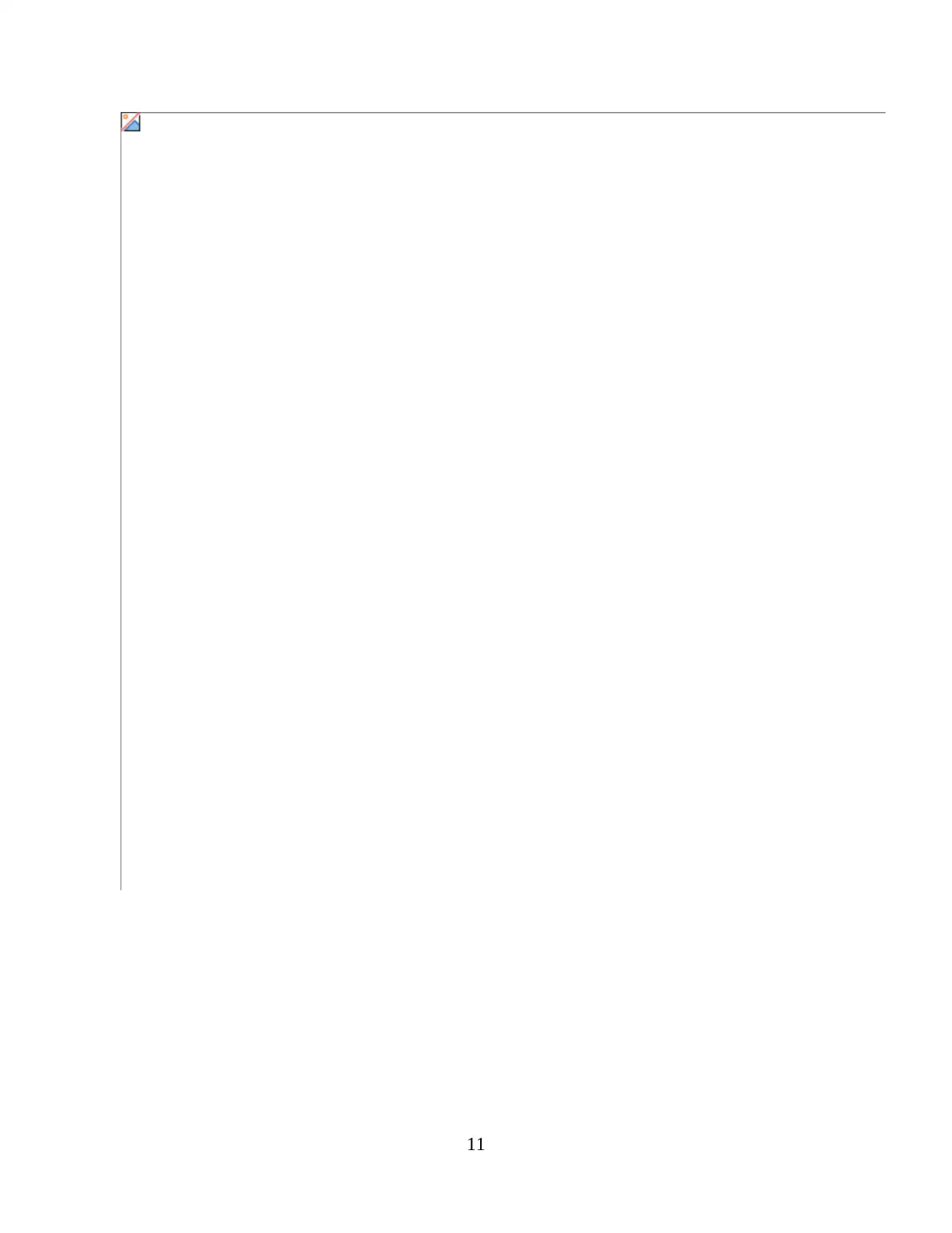
11
1 out of 13
Related Documents
Your All-in-One AI-Powered Toolkit for Academic Success.
+13062052269
info@desklib.com
Available 24*7 on WhatsApp / Email
![[object Object]](/_next/static/media/star-bottom.7253800d.svg)
Unlock your academic potential
© 2024 | Zucol Services PVT LTD | All rights reserved.





